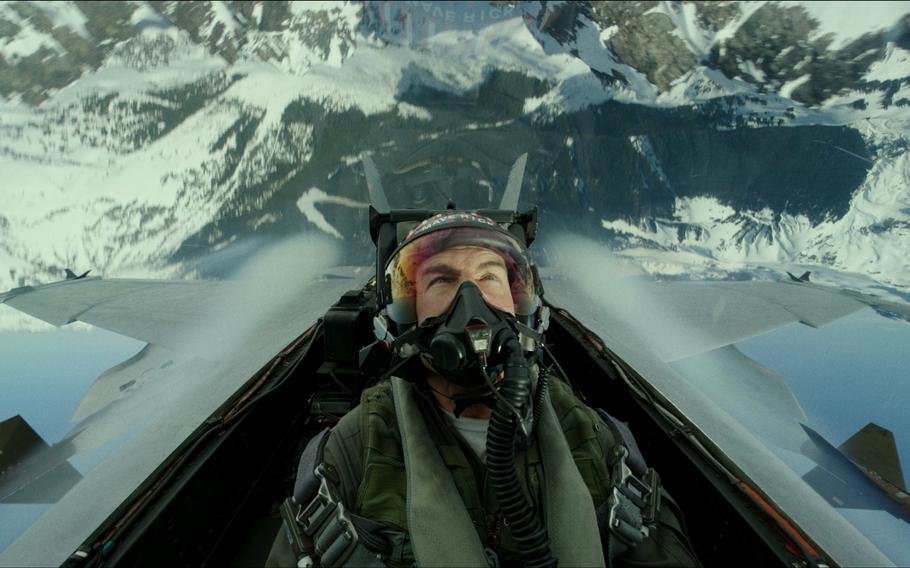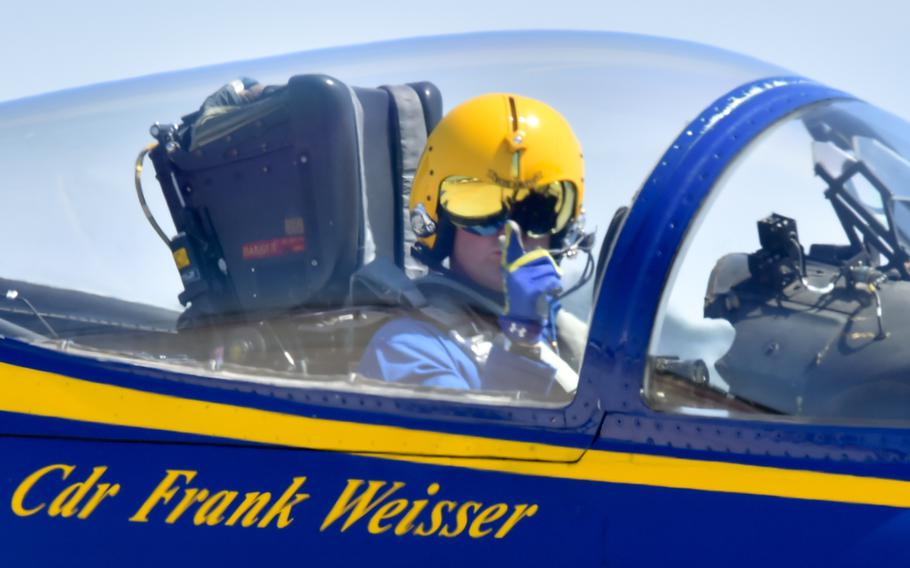
This image released by Paramount Pictures shows Tom Cruise portraying Capt. Pete "Maverick" Mitchell in a scene from "Top Gun: Maverick." (Paramount Pictures)
WASHINGTON — Cmdr. Frank “Walleye” Weisser is a decorated former Navy fighter pilot with decades of experience, thousands of hours in the cockpit and dozens of combat missions under his belt.
But his most famous mission recently made it to the big screen with Weisser flying for Tom Cruise in Hollywood’s big blockbuster of last year — “Top Gun: Maverick.”
“The only reason I became involved is because Tom Cruise and [Producer] Jerry Bruckheimer had a couple scenes they wanted done at extreme low altitudes,” he said. “What’s really cool about this movie is the fact that almost everything you see on that big screen we flew. We really did it.”
Weisser was part of a discussion Thursday hosted by the Military Officers Association of America, a nonprofit, nonpartisan group comprised of active-duty and retired American service members that advocates for a strong national defense and the welfare of military families. Weisser described what it was like to be a naval pilot and how it felt standing in for Cruise in the $170 million, years-in-the-making “Top Gun” sequel — an assignment that took about a year and involved several real-life pilots. Weisser, though, was the one who flew F/A-18 Hornets for risky scenes close to the ground.
“The effects on the ground had to be real, had to be legitimate because you can’t fake that stuff,” he said. “There was only one opportunity to do it because the destruction it causes to the set made the set unusable for any future takes.”
For example, Weisser, a two-time member of the famous Blue Angels unit, was in the cockpit for a scene early in the film that shows a prototype “Darkstar” stealth plane swoop in low, kick up a storm of dust and nearly rattle the roof off a nearby military watchtower.
“The roof of the building did, in fact, come off. That isn’t Hollywood special effects,” he said.
Weisser was also the pilot assigned to perform other potentially risky maneuvers for the movie, which turned out to be a gold mine at the box office, earning almost $1.5 billion in global ticket sales. The low-level flybys and aerial tricks played out in the movie, it was Weisser portraying Cruise’s Col. Pete “Maverick” Mitchell.
“I thought Tom was super. I actually thought all the actors were super. They kind of function like a military organization, too,” he said. “When Tom walks in the room, it’s like a three- or four-star [general] coming in.”
And Cruise plays that part too.
“[Cruise] is exactly what you’d want in a senior leader because he takes himself seriously, works incredibly hard, he cares about the people underneath him and he was constantly mentoring the entire time,” Weisser said.

Then-Cmdr. Frank Weisser, lead solo pilot assigned to the Navy flight demonstration squadron known as the Blue Angels, points to the crowd at a Wings Over Wayne air show in North Carolina in 2017. (Ian Cotter/U.S. Navy)
He knows about leadership. He joined the U.S. Naval Academy after high school in the late 1990s and received his wings in 2002. In the years that followed, he was an instructor pilot and flew missions over Iraq and Afghanistan in the mid-2000s. In 2007, he joined the Navy’s Blue Angels — one of the service’s aerobatic flight demonstration teams that performs at air shows worldwide.
During his time as an aviator, Weisser was given the callsign “Walleye,” which is a bit less flattering than the dangerous-sounding nicknames the pilots have in the Top Gun films. That is pure Hollywood, Weisser said, because pilots are usually given their callsigns — and they usually reflect something they don’t do so well, kind of a way to keep their ego from getting too big.
“In my first fleet squadron, I was flying too close to some of the other aircraft,” he said. “So, the joke was that I had walleye vision and I couldn’t see things properly unless I got too close to them. … It has this really profound effect of bringing you back down if someone gets a little bit [too cocky].”
Then-Lt. Cmdr. Frank Weisser, who was the lead solo pilot of the Blue Angels, signs autographs during Navy Week at the Seattle Seafair in 2010. (Thomas Brennan/U.S. Navy)
Weisser, who became a real estate agent and engagement speaker after his military service, said he had an exciting and adventurous career as a Navy pilot, but he backed into the role. Upon entering the Naval Academy, his dream was to be a Navy SEAL.
“On the day of service selection, I was told I was going to be a Navy pilot. And I was heartbroken,” he said. “I was wrecked for years about it, because it’s not what I wanted to do….At some point, I was able to sort out how to fly these airplanes, and I look back at having had what I think was a very rewarding and exciting job.”
Weisser, along with a handful of other Navy pilots, worked on “Top Gun: Maverick” for about a year in 2018 and 2019. The movie was originally supposed to hit theaters in the summer of 2020, but the coronavirus pandemic pushed the release back several times to Memorial Day weekend in 2022.
So, how did Weisser feel when he finally got to see the movie — and his flight stunts?
“I loved it,” he said. “I was secretly worried that it was going to be a bust and I was going to spend the rest of my life being made fun of for being a part of it.
“I was just so pleased that the [story] was awesome and they really tied in so well back to the [first] movie. … It was kind of a feel-good movie at a time in America when we needed it.”